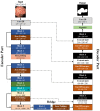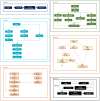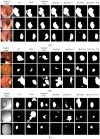IRv2-Net: A Deep Learning Framework for Enhanced Polyp Segmentation Performance Integrating InceptionResNetV2 and UNet Architecture with Test Time Augmentation Techniques
- PMID: 37765780
- PMCID: PMC10534485
- DOI: 10.3390/s23187724
IRv2-Net: A Deep Learning Framework for Enhanced Polyp Segmentation Performance Integrating InceptionResNetV2 and UNet Architecture with Test Time Augmentation Techniques
Abstract
Colorectal polyps in the colon or rectum are precancerous growths that can lead to a more severe disease called colorectal cancer. Accurate segmentation of polyps using medical imaging data is essential for effective diagnosis. However, manual segmentation by endoscopists can be time-consuming, error-prone, and expensive, leading to a high rate of missed anomalies. To solve this problem, an automated diagnostic system based on deep learning algorithms is proposed to find polyps. The proposed IRv2-Net model is developed using the UNet architecture with a pre-trained InceptionResNetV2 encoder to extract most features from the input samples. The Test Time Augmentation (TTA) technique, which utilizes the characteristics of the original, horizontal, and vertical flips, is used to gain precise boundary information and multi-scale image features. The performance of numerous state-of-the-art (SOTA) models is compared using several metrics such as accuracy, Dice Similarity Coefficients (DSC), Intersection Over Union (IoU), precision, and recall. The proposed model is tested on the Kvasir-SEG and CVC-ClinicDB datasets, demonstrating superior performance in handling unseen real-time data. It achieves the highest area coverage in the area under the Receiver Operating Characteristic (ROC-AUC) and area under Precision-Recall (AUC-PR) curves. The model exhibits excellent qualitative testing outcomes across different types of polyps, including more oversized, smaller, over-saturated, sessile, or flat polyps, within the same dataset and across different datasets. Our approach can significantly minimize the number of missed rating difficulties. Lastly, a graphical interface is developed for producing the mask in real-time. The findings of this study have potential applications in clinical colonoscopy procedures and can serve based on further research and development.
Keywords: CVC-ClinicDB; IRv2-Net; Kvasir-SEG; colonoscopy; polyps; segmentation; test time augmentation.
Conflict of interest statement
The authors declare no conflict of interest.
Figures



















Similar articles
-
Focus U-Net: A novel dual attention-gated CNN for polyp segmentation during colonoscopy.Comput Biol Med. 2021 Oct;137:104815. doi: 10.1016/j.compbiomed.2021.104815. Epub 2021 Sep 2. Comput Biol Med. 2021. PMID: 34507156 Free PMC article.
-
Enhanced accuracy with Segmentation of Colorectal Polyp using NanoNetB, and Conditional Random Field Test-Time Augmentation.Front Robot AI. 2024 Aug 9;11:1387491. doi: 10.3389/frobt.2024.1387491. eCollection 2024. Front Robot AI. 2024. PMID: 39184863 Free PMC article.
-
UViT-Seg: An Efficient ViT and U-Net-Based Framework for Accurate Colorectal Polyp Segmentation in Colonoscopy and WCE Images.J Imaging Inform Med. 2024 Oct;37(5):2354-2374. doi: 10.1007/s10278-024-01124-8. Epub 2024 Apr 26. J Imaging Inform Med. 2024. PMID: 38671336 Free PMC article.
-
Artificial intelligence in colonoscopy: from detection to diagnosis.Korean J Intern Med. 2024 Jul;39(4):555-562. doi: 10.3904/kjim.2023.332. Epub 2024 May 2. Korean J Intern Med. 2024. PMID: 38695105 Free PMC article. Review.
-
A Comprehensive Evaluation of Iris Segmentation on Benchmarking Datasets.Sensors (Basel). 2024 Nov 3;24(21):7079. doi: 10.3390/s24217079. Sensors (Basel). 2024. PMID: 39517976 Free PMC article. Review.
Cited by
-
HDL-ACO hybrid deep learning and ant colony optimization for ocular optical coherence tomography image classification.Sci Rep. 2025 Feb 18;15(1):5888. doi: 10.1038/s41598-025-89961-7. Sci Rep. 2025. PMID: 39966596 Free PMC article.
-
Mamba-fusion for privacy-preserving disease prediction.Sci Rep. 2025 Jul 1;15(1):21819. doi: 10.1038/s41598-025-06306-0. Sci Rep. 2025. PMID: 40596404 Free PMC article.
-
An efficient fine tuning strategy of segment anything model for polyp segmentation.Sci Rep. 2025 Apr 23;15(1):14088. doi: 10.1038/s41598-025-97802-w. Sci Rep. 2025. PMID: 40269089 Free PMC article.
-
MugenNet: A Novel Combined Convolution Neural Network and Transformer Network with Application in Colonic Polyp Image Segmentation.Sensors (Basel). 2024 Nov 23;24(23):7473. doi: 10.3390/s24237473. Sensors (Basel). 2024. PMID: 39686010 Free PMC article.
References
-
- Colorectal Cancer: Stages|Cancer.Net. [(accessed on 6 July 2023)]. Available online: https://www.cancer.net/cancer-types/colorectal-cancer/stages.
-
- Hassinger J.P., Hohibar S.D., Pendlirnari R., Dozois E.J., Larson D.W., Cima R.R. Effectiveness of a Multimedia-Based Educational Intervention for Improving Colon Cancer Literacy in Screening Colonoscopy Patients. Dis. Colon Rectum. 2010;53:1301–1307. doi: 10.1007/DCR.0b013e3181e291c0. - DOI - PubMed
-
- Holzheimer R.G., Mannick J.A. Surgical Treatment: Evidence-Based and Problem-Oriented. Zuckschwerdt; Munich, Germany: 2001. - PubMed
MeSH terms
LinkOut - more resources
Full Text Sources
Research Materials

